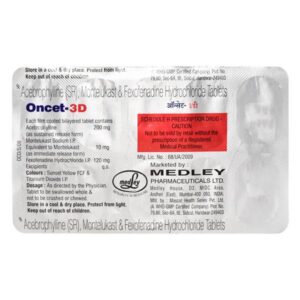FEXOFENADINE + MONTELUKAST + ACEBROPHYLLINE
Fexofenadine: Fexofenadine is an antihistamine drug that is used primarily for the treatment of allergies. It is commonly prescribed to relieve symptoms such as sneezing, itchy or watery eyes, runny nose, and itching.
The mechanism of action of fexofenadine involves blocking the effects of histamine, which is a chemical released by the body during an allergic reaction. By blocking histamine receptors, it helps to reduce or alleviate the uncomfortable symptoms of allergies.
The usual recommended dose of fexofenadine for adults is 180 mg once daily. However, the dosage may vary depending on the specific condition being treated and the individual’s response to the medication. Children usually take a lower dosage based on their body weight. It is important to follow the instructions provided by your healthcare professional or the dosage guidelines on the product label.
Common side effects of fexofenadine may include headache, drowsiness, dizziness, nausea, and dry mouth. These side effects are generally mild and temporary. However, if you experience any severe or persistent side effects, it is important to seek medical attention. It is also important to note that fexofenadine may interact with certain medications or medical conditions, so it is crucial to inform your healthcare professional about all your current medications and medical history before starting fexofenadine.
Montelukast: Montelukast is a prescription medication that is commonly used to prevent and manage symptoms of asthma and allergic rhinitis. It belongs to a class of drugs known as leukotriene receptor antagonists.
The mechanism of action of montelukast involves blocking the action of leukotrienes, which are inflammatory mediators involved in the pathogenesis of asthma and allergic reactions. By inhibiting leukotrienes, montelukast helps to reduce airway inflammation, bronchoconstriction, and mucus production, thereby relieving asthma symptoms and improving lung function.
The usual recommended dose of montelukast for adults and adolescents (over 15 years) with asthma is 10 mg once daily, preferably in the evening. For children aged 6 to 14 years with asthma, the dose is 5 mg once daily. For allergic rhinitis, the recommended dose is 10 mg once daily for adults and adolescents, while for children aged 2 to 5 years, a lower strength dose of 4 mg chewable tablets or oral granules may be used.
Like any medication, montelukast can cause side effects. Common side effects include headache, gastrointestinal disturbances (such as nausea, diarrhea, or stomach pain), fatigue, and flu-like symptoms. Rare but serious side effects may include mood or behavior changes, such as agitation, aggression, or depression. It is important to report any unusual or severe side effects to a healthcare professional.
Montelukast is generally well-tolerated and has a good safety profile. However, it is important to note that montelukast is not a rescue medication for acute asthma attacks and should not be used to treat sudden breathing difficulties. Short-acting bronchodilators should be used for immediate relief during an asthma attack, while montelukast is used as a maintenance therapy to prevent future attacks. It is always advisable to consult a healthcare professional for proper diagnosis, treatment, and management of asthma and allergic conditions.
Acebrophylline: Acebrophylline is a drug belonging to the class of bronchodilators and mucolytics. It is primarily used in the treatment of respiratory conditions such as chronic obstructive pulmonary disease (COPD), bronchial asthma, and chronic bronchitis.
The mechanism of action of acebrophylline involves two key components. Firstly, it acts as a bronchodilator, which means it helps to relax and widen the airways in the lungs. This mechanism helps in improving airflow and making breathing easier for individuals with respiratory conditions. Secondly, acebrophylline possesses mucolytic properties, which means it helps to thin and loosen the mucus in the airways. This action assists in reducing congestion and facilitating the removal of excess mucus from the lungs.
The usual recommended dose of acebrophylline is 100 mg to 200 mg taken orally, twice daily after meals. However, the dosage may vary depending on the individual’s condition and the doctor’s recommendation. It is important to follow the prescribed dosage and duration of treatment to achieve the best results.
Like with any medication, acebrophylline may cause certain side effects. Common side effects include gastrointestinal disturbances such as nausea, vomiting, stomach discomfort, and diarrhea. Additionally, some individuals may experience headaches, dizziness, palpitations, rash, and dry mouth. If any of these side effects persist or worsen, it is important to consult a healthcare professional.
It is worth noting that acebrophylline may interact with other medications, so it is essential to inform the healthcare provider about any other drugs being taken. Individuals with a history of allergies, heart disease, liver or kidney dysfunction, peptic ulcers, or seizure disorders should exercise caution while using acebrophylline.
Overall, acebrophylline is a medication used for the management of respiratory conditions and helps in widening the airways and reducing mucus congestion. It is important to take the medication as prescribed and consult a healthcare professional for any concerns or side effects.

